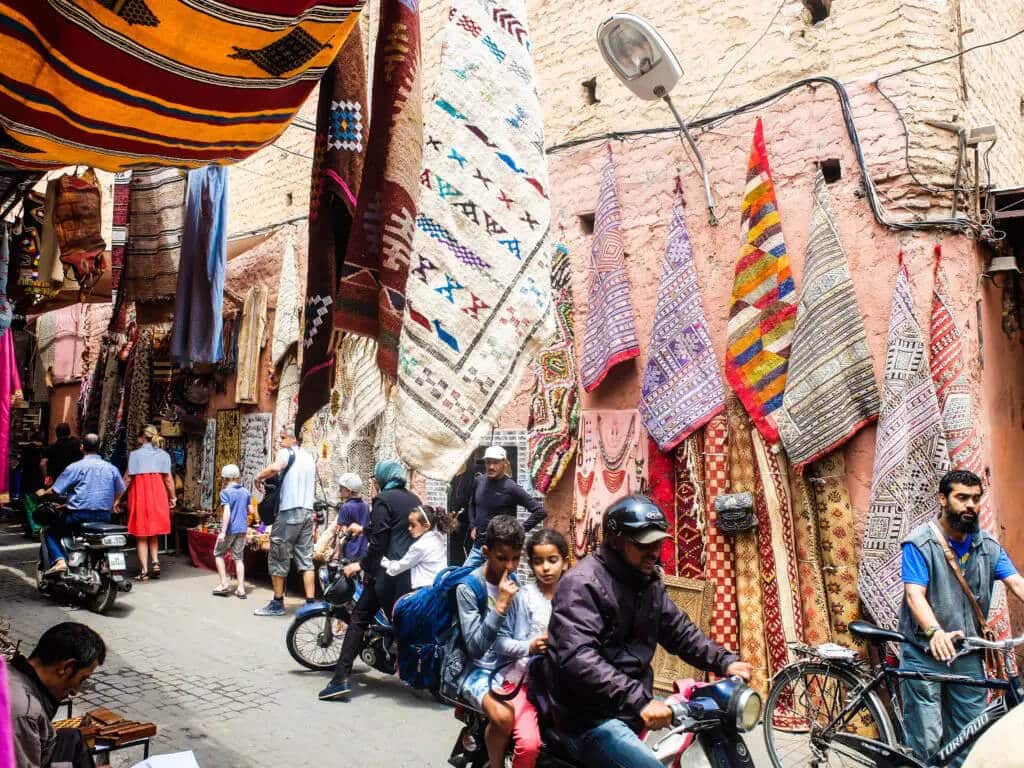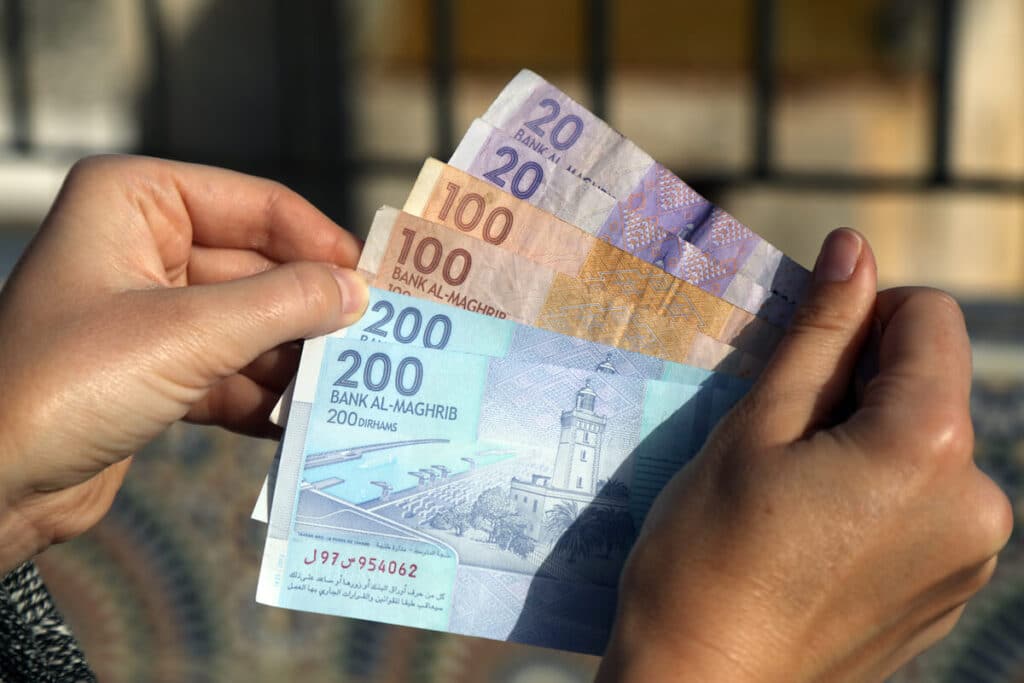Last updated on March 5th, 2024 at 09:59 pm

When you think of the Kingdom of Morocco, you may have visions of Casablanca, the Western Sahara, beautiful blue doorways, and ornate Islamic architecture. Do you also picture the dirham or santim?
If you’re planning to visit Morocco, whether for tourism or a family reunion, you’ll want to know more about the official currency, the Moroccan dirham.
Here’s what you need to know about Morocco’s currency and how to get the best dirham exchange rate.
What is the dirham?
The dirham is the official currency of the Kingdom of Morocco, with one dirham equal to 100 santimat. Morocco is a multilingual nation, where many people speak French, Arabic, and other local languages, and its currency is too. The Arabic word “santim” is “centime” in French, while the plural “santimat” becomes “centimes.”
Morocco isn’t the only country that uses the dirham as its unit of currency. The dirham is also the official currency of the United Arab Emirates, and it’s a subdivision of the local currency in Libya and Jordan (the dinar) and in Qatar (the riyal).
But it’s easy to distinguish the Moroccan dirham from the United Arab Emirates dirham, as it says the words “Bank al-Maghrib” on the front of every banknote. The UAE dirham, on the other hand, comes from the Central Bank of the United Arab Emirates. Dirham coins, however, can be a little harder to tell apart.
Moroccan currency basics
- Currency code: MAD
- Abbreviation: DH
- Coin denominations: 1, 2, 5, and 10
- Banknote denominations: 10, 20, 50, 100, and 200
- Sentimat/centimes: 5, 10, 20, and 50
A short history of Morocco’s currency
The Arabic word “dirham” comes from the Ancient Greek word “drachma.” So, how did the term for Greek currency end up in Morocco? It’s simple: conquest and trade.
At the height of the Byzantine Empire around 600 AD, the Greek realm stretched across Northern Africa, particularly the seaports, all the way to Persia, and the Greeks traded with many others outside their empire.
The drachma made its way into other civilizations, including those of Persia, Moorish Spain, and the region that would later become the Ottoman Empire.
But as power changed hands, Morocco’s currency changed, too. Until 1882, Morocco still used copper, silver, and gold to mint coins. The silver coins were called dirham.
The dirham retained its status as the second-most valuable currency after the Moroccan rial came into play. The rial lasted until 1921 when France invaded Morocco.
Ever heard of the 1942 movie Casablanca? It took place during the French occupation of the country, when the franc, not the dirham, was the official currency.
After Moroccan independence in 1960, the dirham came back onto the scene, and this time as the primary currency in Morocco.
Understanding currency exchange in Morocco

Many factors affect currency exchange rates, from government stability to the state of the national economy. While the Kingdom of Morocco has been more progressive under the current king, Mohammed VI, the inflation rate has increased lately due to the COVID-19 outbreak, the war in Ukraine, and an extreme drought.
Morocco’s economy depends heavily on trade and tourism, and its overall growth also fluctuates depending on the health of its agriculture sector.
The Moroccan dirham’s value can rise and fall relative to other major currencies. You can exchange your EUR, GBP, or USD into MAD at any time, but check the current exchange rate to ensure that you’re getting the best price.
5 facts about the Moroccan dirham
What makes the dirham so special? Let’s dig into a few interesting facts about Morocco’s currency.
1. The first dirham notes were printed over old francs.
A new country has a lot on its plate. That’s one of the reasons why, when the modern dirham was first introduced in 1960, the 100 and 50 dirham notes were overprints on the original franc banknotes. The 100 dirham note was printed over the 10,000 franc notes and the new 50 note over the 5,000 franc banknotes.
2. The actual plural of dirham is darahim.
Plurals in Arabic work a bit differently than in English. In English, we add an “s” to the end of a word to signify that there is more than one of that thing. That’s why an English speaker’s first instinct is to turn dirham into dirhams.
But in Arabic, some words create a “broken plural,” which is when the middle sounds change. That’s why dirham becomes darahim.
It’s OK if you stick to just using “dirham.” In tourist-friendly cities such as Casablanca, Tangier, and Marrakesh, residents are familiar with the English or French versions of the word.
3. Countryside markets might use different names.
In the 18th century, the Moroccan currency system used the Spanish coin system as a reference. This inspired alternative names for the dirham, including the “duro” and “real” for the silver dirham coins. You may still hear these terms used in the countryside markets of Morocco.
4. Dirham banknotes feature the current king of the Kingdom of Morocco.
If you’ve ever seen or held a dirham banknote, then you may have noticed that a man appears on each one. That’s the monarch of the Kingdom of Morocco. Starting in 1987, the notes featured King Hassan II. Since he passed away in 1999, a new note displays his successor, Mohammed VI. This version appears from 2002 onward.
5. Both the rial and the franc are still used … sort of.
The dirham consists of 100 santimat, or centimes if you’re speaking French. However, you can still hear some locals calling 5 santimat a “rial” and 1 santim a “franc.” This is likely because when the new currency appeared in the 1960s, one dirham equaled 100 francs. It was only in 1974 that the santim replaced the franc as the lower denomination of Morocco’s currency.
Exchanging, Converting, and Using Morocco’s Currency
The Moroccan dirham is a closed currency, which means you can’t buy it freely outside the country. Because of this, if you’re visiting Morocco, you should only exchange the amount you think you’ll need and make sure to spend all of it while in the country.
Generally, you’ll need cash for marketplaces, small shops, and emergencies, as well as in locations outside the major cities. You should be able to use your credit card or debit card at most mid-to-large hotels, luxury restaurants, and malls, which typically accept Visa and Mastercard.
If you plan to exchange your U.K. pounds, euros, or USD to MAD in Morocco, you’ll have two options when you arrive in the country: currency exchange agencies (or “bureau de change” in French), and the airport counter.
However, the easiest way to get travel money in Morocco is simply to use an ATM to convert your pounds, euros, or dollars to Moroccan dirham. It depends on your bank, but usually, ATM fees are less than those at a currency exchange office.
Check with your bank to find out about their out-of-network or international ATM fees before you travel. Here are some more tips on using Morocco’s currency:
- Break 100 and 200 DM notes when you can.
- Vendors prefer small notes, such as the 5, 10, and 20 DM.
- Keep exact change for taxis.
- If your restaurant bill doesn’t include a tip, consider giving a 10% tip.
- Don’t try to bring in money with traveler’s checks. Most Moroccan banks won’t accept them.
Sending money to Morocco

As we mentioned, since the currency of Morocco is a closed currency, so you can’t buy and sell it outside the country. But you can still send money to friends or family members in Morocco or into your own Moroccan bank account from overseas.
For affordable money transfer to Morocco, look closely at fees. Since the exchange rate from USD to MAD, EUR to MAD, and GBP to MAD is fairly stable, focusing on lowering your transfer fees will save you more.
You’ll also want to see where and how your loved ones can receive the funds you send. Look for transfer companies with a wide network of partners in Morocco, like Remitly.
With Remitly, you can send funds quickly and safely to a bank account in Morocco, or for your friends or relatives to pick up in cash.
Download the app today, and we’ll show you how to get started.
